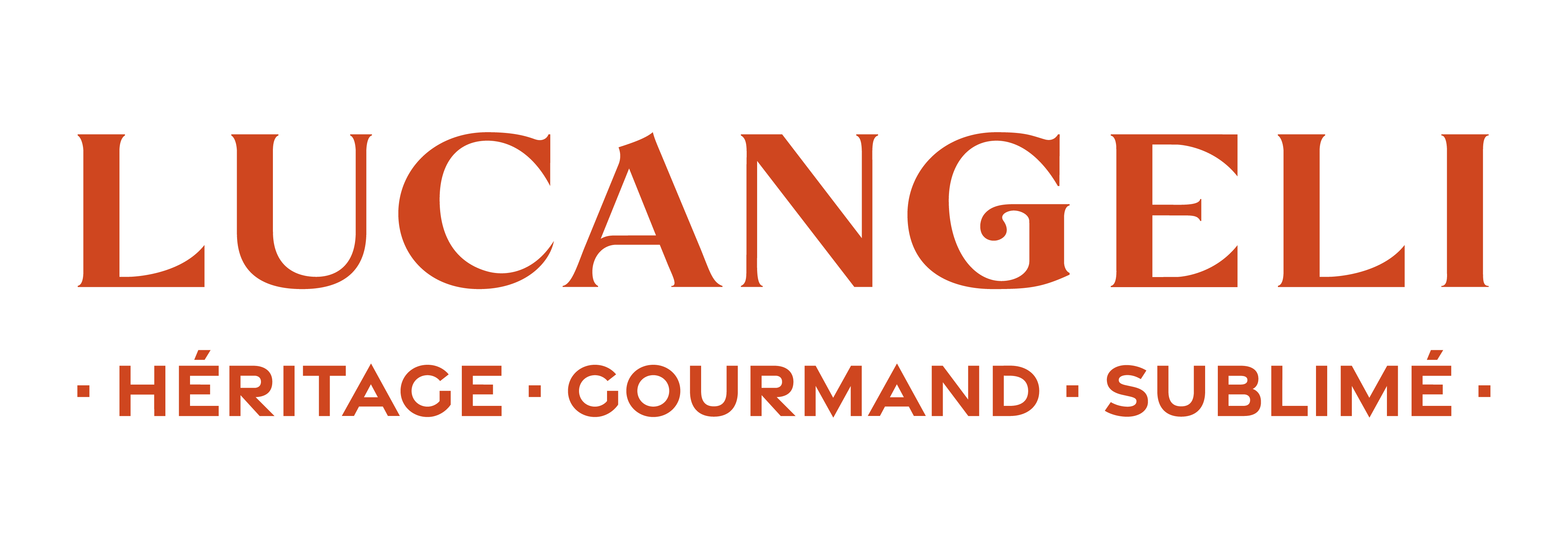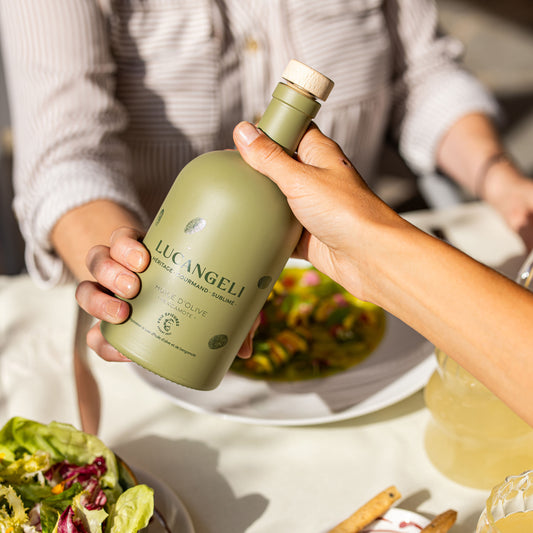Italian olive oil is the epitome of variety and quality in the world of gastronomy. This golden elixir is produced from a specific selection of olives grown in various regions of Italy , particularly in Calabria and Puglia. The production of this oil, made primarily by cold pressing, follows a thousand-year-old tradition of craftsmanship and agriculture. The final product, extra virgin olive oil, is known for its distinct aromas, delicate flavor, and numerous nutritional benefits, including its richness in antioxidants, vitamins, and polyphenols.
The History of Olive Oil in Italy
Italian olive oil , the epitome of variety and quality , embodies a tradition deeply rooted in Italy 's Mediterranean history. Its production process, which dates back two millennia, highlights the importance of the olive in Italian agriculture and gastronomy. Unique olive varieties, such as the Taggiasca Olive, the Leccino Olive, the Coratina Olive, the Carolea Olive and the Geracese Olive, are distinguished by their specific terroir, their history and their unique flavor. These varieties are protected by specific designations ( DOC and PDO ), guaranteeing their traceability and exceptional quality. Thanks to careful extraction and respect for traditional methods, Italy continues to export its extra virgin olive oils, prized by gourmets around the world.
The different varieties of Italian olive oil
Italian olive oil is the epitome of variety and quality, with production spanning several regions of the country. Each region, with its unique terroir, produces a specific variety of oil, offering a range of distinct flavors and aromas. From cold-pressed extra virgin to traditional olive oil, Italy prides itself on its extraction and harvesting techniques, which have been perfected over millennia. Olives such as Taggiasca, Leccino, Coratina, Geracese, and Carolea are all used in the creation of these precious oils, each bringing its own unique touch to the final bottle.
Tuscan olive oil: a robust and spicy flavor
Tuscany , famous for its ancient olive cultivation, is particularly well-known for its extra virgin olive oil. Tuscan oil is often extracted from Frantoio, Leccino, and Moraiolo olives, offering a robust, spicy flavor that is highly valued in gastronomy. Tuscan oils often carry the DOP (Denominazione di Origine Protetta) designation, a sign of their provenance and exceptional quality. Additionally, Tuscan olive oil is rich in polyphenols and antioxidants, giving it numerous nutritional and health benefits.
The Pugliese variety: the most produced in Italy
Puglia , in southern Italy, is the region that produces the most olive oil in the country. Coratina and Ogliarola olive varieties are commonly used to produce premium extra virgin olive oil. Pugliese oil has a mild, fruity flavor with a slight bitterness reminiscent of freshly picked olives . It is ideal for cooking or as an accompaniment to dishes from the Mediterranean diet. Like Tuscan oil, Pugliese oil often has the DOP or IGP (Indicazione Geografica Protetta) designation, indicating its precise origin and artisanal production process.
The production process of Italian olive oil
Italian olive oil is the epitome of variety, a true symphony of flavors and aromas that reflects the richness of the Italian terroir. Each region, from Tuscany to Puglia, produces a unique olive oil, derived from a specific combination of olive varieties such as Taggiasca, Leccino, Coratina, Geracese, and Carolea. This precious liquid, rich in antioxidants, vitamins, and polyphenols, is the result of a millennia-old production process that blends tradition and innovation.
The olive harvest
The olive harvest is a crucial step in the production of Italian olive oil . It's a time of year when every tree is carefully inspected and every olive is hand-selected to ensure the highest quality. This traditional harvesting method, combined with environmentally friendly farming, ensures that only the best olives are used to make extra virgin olive oil. Each olive is a treasure of the Mediterranean, full of flavor and nutrition.
Olive oil extraction
Oil extraction is another important aspect of Italian olive oil production. The process begins with cold-pressing the olives, a method that preserves all the fruit's nutritional benefits and intense aromas. The oil is then filtered and stored in dark glass bottles to protect its quality and flavor. Each bottle of Italian olive oil bears a specific designation, such as DOP (Denominazione di Origine Protetta) or IGP (Indicazione Geografica Protetta), which attests to its provenance and authenticity. From cooking to eating, Italian olive oil is a staple of global gastronomy, a true symbol of Italian culture and craftsmanship.
The Health Benefits of Italian Olive Oil
Italian olive oil , especially the extra virgin variety obtained by cold pressing, is a true treasure for health. Its richness in polyphenols, vitamins and antioxidants gives it exceptional virtues. In Italy, olive oil is at the heart of gastronomy but also of the wellness tradition. It is produced in various regions of the country, notably in Tuscany and Puglia, where the production of olive oil is a true age-old art.
The nutritional properties of olive oil
The secret to the quality of Italian olive oil lies in its origin and the care taken at every stage of its production, from harvest to extraction. The olives used, such as Leccino and Coratina, are carefully selected for their unique flavor and nutritional qualities. The Protected Designation of Origin (DOP) and the Protected Geographical Indication (PGI) are labels that guarantee the origin and quality of Italian olive oil. Rich in vitamins E and K, monounsaturated fatty acids, and antioxidants, this oil is a valuable ally for health.
The benefits of olive oil for the heart
Italian olive oil is particularly renowned for its heart-healthy benefits. The monounsaturated fatty acids it contains help lower bad cholesterol (LDL) while increasing good cholesterol (HDL). The polyphenols it contains also have anti-inflammatory and antioxidant properties that help fight cellular aging. When included in a balanced Mediterranean diet, Italian olive oil helps prevent cardiovascular disease and maintain a healthy heart.
Italian olive oil is truly the epitome of variety , a jewel of world gastronomy. It is the fruit of a thousand-year-old tradition, a culture respectful of the terroir and a rigorous selection of the best olives. Its delicate aromas, pronounced flavor and nutritional benefits make it a product of choice for gourmets around the world.
The olives used to make Italian extra virgin olive oil come primarily from two regions: Tuscany and Puglia. Each of these regions produces olive oils with distinct characteristics, thanks to specific olive varieties such as Leccino, Coratina, Ogliarola, Frantoio, and Taggiasca. The olive oils produced here are often monovarietal, meaning they are made from a single olive variety.
Italian olive oil is produced by cold pressing, an extraction method that maximizes the vitamins, antioxidants, and polyphenols present in olives. Italian olive oils often carry the DOP (Denominazione di Origine Protetta) and IGP (Indicazione Geografica Protetta) designations, a guarantee of their origin and quality. Olive oil production in Italy is a true craft, with each bottle reflecting time-honored expertise.
The role of olive oil in Italian cuisine
Olive oil plays a central role in Italian cuisine . It is used both for cooking and for seasoning dishes. Its distinctive flavor adds a unique touch to traditional Italian recipes, from simple tomato salad to Neapolitan pizza and risotto. But Italian olive oil is not only appreciated for its flavor: it is also recognized for its health benefits, due to its richness in antioxidants and monounsaturated fatty acids. It is one of the pillars of the Mediterranean diet , considered one of the healthiest in the world.














 lucangeli.it
lucangeli.it


